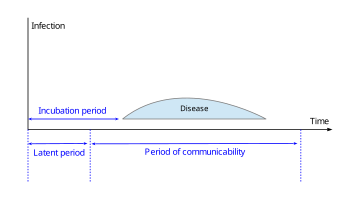
In epidemiology, particularly in the discussion of infectious disease dynamics (modeling), the latent period (also known as the latency period or the pre-infectious period) is the time interval between when an individual or host is infected by a pathogen and when that individual becomes infectious, i.e. capable of transmitting pathogens to other susceptible individuals.[1][2][3]
- ^ Kenrad E. Nelson; Carolyn Masters Williams, eds. (2014), Infectious disease epidemiology: Theory and Practice (3rd ed.), Jones & Bartlett Learning, p. 135-136
- ^ Emilia Vynnycky; Richard G. White (2010), An Introduction to Infectious Disease Modelling, Oxford University Press, p. 2-3
- ^ Michael Y. Li (2018), An Introduction to Mathematical Modeling of Infectious Diseases, Springer International Publishing AG, p. 25
